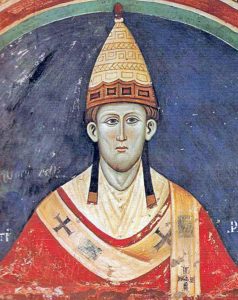 Pope Innocent’s active persecution of the Jews and his instigation of the massacre of the Albigenses resulted in 300 rabbis from France and from the south of England emigrating to Jerusalem (e.g. at the invitation of Saladin. The poet Jehudah Halevi had stirred their yearning for the Holy Land.
Pope Innocent’s active persecution of the Jews and his instigation of the massacre of the Albigenses resulted in 300 rabbis from France and from the south of England emigrating to Jerusalem (e.g. at the invitation of Saladin. The poet Jehudah Halevi had stirred their yearning for the Holy Land.
They sent an advance guard in 1210. As they passed through Egypt in 1211, Sultan el ‘Aziz gave the rabbis a cordial reception. At Hebron they were met by the Exilarch, or Prince of the Captivity, David of Mosul, who was functioning in the East. They entered the Cave of Machpelah, viewed the tombs of the Patriarchs, and one of them (e.g. Rabbi Samuel Ben Samson) wrote an accurate description of the interior of the Cave. The leaders of this rabbinic settlement were Jonathan ben Simeon, and Joseph ben Baruch. They built houses of prayer in Jerusalem, and their presence in the city is referred to by Al Harizi, the Spanish Hebrew poet, who wrote a poetic narrative of his travel experiences.
Source: De Haas, Jacob. History of Palestine – The Last Two Thousand Years. (p. 267); Graetz, III, p. 522; El Carmoly, Itinéraires de la Terre Sainte, etc, Brussels, 1847, p. 129; Archives de l’Orient Latin, I, p. 231 ; Kollek, Teddy; Pearlman, Moshe. Pilgrims to the Holy Land: The story of Pilgrimage Through the Ages. P 126.